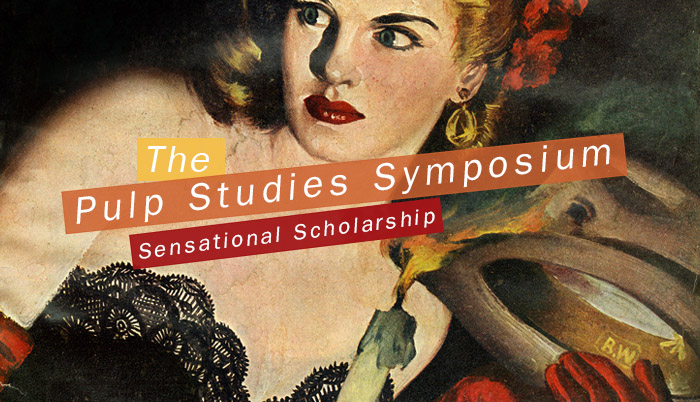Presentation Title
Gender Bending in Pulp Fiction: The Scientific Interventions of Clare Winger Harris, Leslie F. Stone, Isabel Martin Lewis, and David H. Keller
Abstract
Women were prominent in the world of the pulps, both as writers and as readers, but it is sometimes thought that they were not successful as science fiction writers until the 1970s. The claim that women were marginalized could be in part due to the kind of women’s writing that appeared. When studying fiction in the 1920s and 1930s, today’s readers might not recognize what they would see as women’s themes or strong female characters.
By connecting their writing to contemporary scientific debates about sex, however, one can see their pointed attacks on scientific sexism. The developing field of endocrinology and the concomitant realization that women were not a separate species but biologically similar to men made it obvious that segregated education and public roles were based on custom, not scientific fact. Popular magazines show clearly the complicated relationship between science and women, if one knows how to identify this approach. Both Harris and Stone, for instance, wrote stories that hinged on fallacies concerning evolutionary thought (such as Stone’s “Women with Wings”); even though the female characters do not rail against stereotypes, the science that enforces the stereotype is demonstrated as fallacious. Harris and Stone both engage with evolutionary theory and the explore the supposedly plain typology of women to explode the science that justified the sequestration of women.
Authors of fiction like Harris and Stone were joined by others who engaged in a sort of performance art. One is Lewis, an astronomer, who did not make any feminist pronouncements in her writing, but her path from hand “calculator” to astronomer showed that women do not go against their biology when they think analytically at a time when women were routinely discriminated against in scientific university posts. The other is Keller, whose popular stories under the pseudonym of Amy Worth exploded mainstream misconceptions about feminist movements and the supposed fixed biological traits of the sexes.
Taken together, these authors can be seen as making interventions into the ideology of supposed sexual differences in aptitudes based in biology. Pulp readers, who were accustomed to authors who weaved together different kinds of discourse, in science fiction are shown the consequences of different scientific frameworks: if women must be careful to avoid damaging the biological inheritance of their children because the race is so mutable, then would not one see the race changing all the time? If women are incapable of public affairs, then why do their organizations differ from those of men? These authors provide a valuable testing ground for the investigation of new scientific developments, helping their readers imagine the consequences of a changing paradigm.
Gender Bending in Pulp Fiction: The Scientific Interventions of Clare Winger Harris, Leslie F. Stone, Isabel Martin Lewis, and David H. Keller
Women were prominent in the world of the pulps, both as writers and as readers, but it is sometimes thought that they were not successful as science fiction writers until the 1970s. The claim that women were marginalized could be in part due to the kind of women’s writing that appeared. When studying fiction in the 1920s and 1930s, today’s readers might not recognize what they would see as women’s themes or strong female characters.
By connecting their writing to contemporary scientific debates about sex, however, one can see their pointed attacks on scientific sexism. The developing field of endocrinology and the concomitant realization that women were not a separate species but biologically similar to men made it obvious that segregated education and public roles were based on custom, not scientific fact. Popular magazines show clearly the complicated relationship between science and women, if one knows how to identify this approach. Both Harris and Stone, for instance, wrote stories that hinged on fallacies concerning evolutionary thought (such as Stone’s “Women with Wings”); even though the female characters do not rail against stereotypes, the science that enforces the stereotype is demonstrated as fallacious. Harris and Stone both engage with evolutionary theory and the explore the supposedly plain typology of women to explode the science that justified the sequestration of women.
Authors of fiction like Harris and Stone were joined by others who engaged in a sort of performance art. One is Lewis, an astronomer, who did not make any feminist pronouncements in her writing, but her path from hand “calculator” to astronomer showed that women do not go against their biology when they think analytically at a time when women were routinely discriminated against in scientific university posts. The other is Keller, whose popular stories under the pseudonym of Amy Worth exploded mainstream misconceptions about feminist movements and the supposed fixed biological traits of the sexes.
Taken together, these authors can be seen as making interventions into the ideology of supposed sexual differences in aptitudes based in biology. Pulp readers, who were accustomed to authors who weaved together different kinds of discourse, in science fiction are shown the consequences of different scientific frameworks: if women must be careful to avoid damaging the biological inheritance of their children because the race is so mutable, then would not one see the race changing all the time? If women are incapable of public affairs, then why do their organizations differ from those of men? These authors provide a valuable testing ground for the investigation of new scientific developments, helping their readers imagine the consequences of a changing paradigm.


